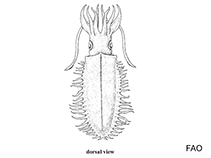Chtenopteryx canariensis Salcedo-Vargas & Guerrero-Kommritz, 2000
Canaries comb-finned squidGoogle image | No image available for this species;
drawing shows typical species in Chtenopterygidae.
Classification / Names Common names | Synonyms | CoL | ITIS | WoRMS
Cephalopoda | Bathyteuthida | Chtenopterygidae
Environment: milieu / climate zone / depth range / distribution range Ecology
Demersal; depth range ? - 1000 m (Ref. 104052). Tropical
Distribution Countries | FAO areas | Ecosystems | Occurrences | Introductions
Atlantic Ocean.
Length at first maturity / Size / Weight / Age
Maturity: Lm ? range ? - ? cm Max length : 6.5 cm ML male/unsexed; (Ref. 104052)
Life cycle and mating behavior Maturity | Reproduction | Spawning | Eggs | Fecundity | Larvae
Main reference
References | Coordinator | Collaborators
Salcedo-Vargas, M.A. and J. Guerrero-Kommritz 2000 Three new cephalopods from the Atlantic Ocean. Mitteilungen aus dem Hamburgischen Zoologischen Museum und Institut 97:31-44. (Ref. 84335)
IUCN Red List Status
(Ref. 130435: Version 2025-1)
CITES status (Ref. 108899)
CMS (Ref. 116361)
Threat to humans
Human uses
Fisheries: of no interest
| FishSource |
Tools
More information
Diet composition
Food consumption
Predators
Max. ages / sizes
Length-weight rel.
Length-length rel.
Length-frequencies
Mass conversion
Abundance
Internet sources
BHL | BOLD Systems | CISTI | DiscoverLife | FAO(Publication : search) | Fishipedia | GenBank (genome, nucleotide) | GloBI | Gomexsi | Google Books | Google Scholar | Google | PubMed | Tree of Life | Wikipedia (Go, Search) | Zoological Record



